Day One
The students line up at the door, blindfolded, and are led into the dark classroom where they take their seats. The message played above introduces them to their "new surroundings". They learn they are political prisoners under a totalitarian regime for fomenting insurrection. They must escape to continue the work of Revolution. However, in order to escape, they must complete the tasks set before them, and learn about the rights given to the people by the Constitutional amendments.
When the "prisoners" awaken they find that their key to freedom is locked tight. The only clue they have is on the table in front of them; a tablet with a simple instruction..."Open Me".
The students then completed a matching activity, with one side of the puzzle containing original text from the Bill of Rights, and the other side containing a "modern" translation of that text. Students had to match the correct sides in order to find the code to unlock the next step. Eventually they discover another video message.
Fully intrigued at this point, the students scramble around the room searching for "The Four Branches". One student discovers a small wooden gavel on top of a book and shouts "the judicial branch!!". Another finds a law book, then a presidential biography...but what's the fourth branch? This offered a great moment to pause the chaos and discuss what could possibly be another check on the powers of government. After brief discussion one student notices a newspaper on a desk and reveals the identity of the fourth estate. Now the real codebreaking begins.
Can you do it? Use the pigpen cipher below to crack the code above!
The time to crack the four different codes varied from group to group, but all groups ended up cracking their hidden messages. As the hidden locations were discovered, students grabbed a pass from "The Overseer" (yours truly) and ran out the door to various parts of the building. When they returned, day one was over.
Day Two
Students access their next steps they gathered from different sources around the building back in their "cells". With their group, they work out directions for an activity to create pieces of propaganda to hang up around the "prison". Each student selects and amendment from the Constitution and creates a brief digital presentation. Here are a few posters created by the students:
After their submissions to "The Overseer" students are given their final clues to the locks on the box containing "The Key to Freedom".
 |
| Thinking... |
 |
| Only one more lock to go! |
 |
| Victory! |
Students discover that the inside of the box contained only a word: "Progress". The class then had a discussion of what this meant, and how the fight for true freedom and liberty is a fight that never really ends.
















Mr B! This is awesome! The flexibility of your approach - the fact that puzzles accented the task, rather than being the task itself - inspires me to bring Breakout-style activities back into my class... Yay!
ReplyDeleteSuper Cool and the images of students focused and thoughtful are remarkable. Thanks for sharing.
ReplyDelete